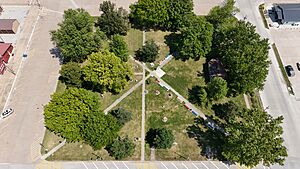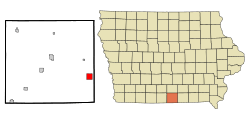Seymour, Iowa facts for kids
Quick facts for kids
Seymour, Iowa
|
|
|---|---|
|
City
|
|

A city park in the central square of Seymour, Iowa
|
|

Location of Seymour, Iowa
|
|
| Country | USA |
| State | |
| County | Wayne |
| Area | |
| • Total | 2.39 sq mi (6.20 km2) |
| • Land | 2.39 sq mi (6.20 km2) |
| • Water | 0.00 sq mi (0.00 km2) |
| Elevation | 1,076 ft (328 m) |
| Population
(2020)
|
|
| • Total | 634 |
| • Density | 265.05/sq mi (102.32/km2) |
| Time zone | UTC−6 (Central (CST)) |
| • Summer (DST) | UTC−5 (CDT) |
| ZIP code |
52590
|
| Area code(s) | 641 |
| FIPS code | 19-71760 |
| GNIS feature ID | 2395851 |
Seymour is a city located in Wayne County, Iowa, in the United States. In 2020, about 634 people lived there. It's a small community with a history tied to coal mining and railroads.
Contents
History of Seymour, Iowa
Early Coal Mining in Seymour
The first coal mines in Seymour started operating in 1884. These mines were important for the area's economy. In 1902, a company called Numa Block Coal Company took over these mines.
Big Jim and Sunshine Mines
By 1908, one of the biggest coal mines in the Appanoose-Wayne Coalfield was Numa Block number 2. It was known as "Big Jim." This mine was located just one mile east of the Chicago, Milwaukee and St. Paul Railway Depot. At its busiest, "Big Jim" could produce 100,000 tons of coal each year.
Another important mine was Numa Block Mine number 3, called the Sunshine Mine. It was in the southeast part of town. This mine was served by the Rock Island railroad.
Workers' Unions in Seymour
In 1884, a group called Local Assembly 3143 of the Knights of Labor was active in Seymour. This group had 40 members and worked to protect the rights of workers.
Later, in 1912, the United Mine Workers Local 206 in Seymour had 299 members. This was about 13% of the city's total population at the time. This shows how many people in Seymour worked in the coal mines.
2017 Tornado Event
On March 6, 2017, an EF-2 tornado hit Seymour around 8:00 pm. An EF-2 tornado is a strong tornado that can cause significant damage. The tornado damaged homes and the high school in the city.
Geography of Seymour
Seymour covers a total area of about 2.35 square miles (6.20 square kilometers). All of this area is land. The city is located in a part of Iowa that is mostly flat, with some rolling hills.
Transportation in Seymour
Roads and Highways
Seymour is connected by a county-maintained road. This road used to be called Iowa Highway 55. Now, it is known as County Road S60. This road helps people travel in and out of the city.
Railroad Connections
Seymour is served by the CPKC Railroad. This railroad used to be part of the Canadian Pacific Railway. It operates on tracks that were once used by the Milwaukee Railroad.
The city was also served by the Chicago, Rock Island and Pacific Railroad (CRI&P), often called the Rock Island. This railroad line ran through the southwest corner of the town square. It had a depot in that area. The Rock Island line was abandoned in the early 1980s when the company went out of business. This line was once part of the "Golden State Route," a special passenger train service.
The two main railroad lines crossed each other at the western edge of Seymour. This crossing was protected by an interlocking tower. The tower helped manage train traffic safely until the Rock Island line was no longer used.
Population and People
| Historical populations | ||
|---|---|---|
| Year | Pop. | ±% |
| 1880 | 501 | — |
| 1890 | 1,058 | +111.2% |
| 1900 | 1,703 | +61.0% |
| 1910 | 2,290 | +34.5% |
| 1920 | 1,746 | −23.8% |
| 1930 | 1,571 | −10.0% |
| 1940 | 1,539 | −2.0% |
| 1950 | 1,223 | −20.5% |
| 1960 | 1,117 | −8.7% |
| 1970 | 931 | −16.7% |
| 1980 | 1,036 | +11.3% |
| 1990 | 869 | −16.1% |
| 2000 | 810 | −6.8% |
| 2010 | 701 | −13.5% |
| 2020 | 634 | −9.6% |
| Iowa Data Center Source: |
||
What the 2020 Census Shows
The 2020 census counted 634 people living in Seymour. There were 274 households in the city. The population density was about 265 people per square mile.
Most of the people living in Seymour were White (93.1%). About 5.8% of the population identified as being from two or more races. About 1.6% of the people were of Hispanic or Latino background.
The average age of people in Seymour was 41.6 years.
- About 26.3% of residents were under 20 years old.
- About 20.5% were 65 years or older.
- The population was almost evenly split between males (48.1%) and females (51.9%).
What the 2010 Census Showed
In 2010, the census counted 701 people in Seymour. There were 295 households. The population density was about 298 people per square mile.
Most residents (98.7%) were White. About 1.6% of the population was Hispanic or Latino.
The average age in 2010 was 47.1 years.
- About 20.8% of residents were under 18 years old.
- About 24.5% were 65 years or older.
- The population was 48.5% male and 51.5% female.
Education in Seymour
The Seymour Community School District is responsible for the public schools in the local area. This district provides education for children living in Seymour and the surrounding communities.
Notable People from Seymour
- John C. Mabee: He was known for owning and breeding Thoroughbred racehorses.
- Marcus Collins: An actor and singer, he is part of the musical group called The Texas Tenors.
- Jane Wilson: A well-known painter.
See also
 In Spanish: Seymour (Iowa) para niños
In Spanish: Seymour (Iowa) para niños

